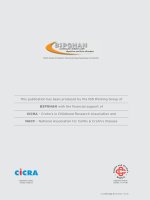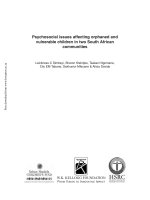Children Under Siege: Safeguarding Provisions for Children in the New Health Law potx
Bạn đang xem bản rút gọn của tài liệu. Xem và tải ngay bản đầy đủ của tài liệu tại đây (809.96 KB, 13 trang )
Children Under S
Children Under S
ie
ie
ge:
ge:
Safeguarding Provisions for Children in
Safeguarding Provisions for Children in
the
the
New Health Law
New Health Law
A Children’s Health Fund Special Report
March 2011
Contacts
Irwin Redlener, MD
President, Children’s Health Fund
&
Professor of Clinical Population and Family Health
Columbia University Mailman School of Public Health
Office: (212) 535-9707
Dennis Johnson, MPA
Executive Vice President, Policy and Advocacy, Children’s Health Fund
Office: (212) 535-9400 x238
Caroline DeRosa, MA
Senior Director of Policy and Advocacy, Children’s Health Fund
Office: (212) 535-9400 x291
Deirdre Byrne
Director of Policy, Children’s Health Fund
Office: (212) 535-9400 x207
Christie Petrone
Communications Manager, Children’s Health Fund
Office: (212) 535-9400 x244
Children Under Siege:
Safeguarding Provisions for Children in the New Health Law
3
INTRODUCTION
Children’s Health Fund (CHF) estimates that approximately 34% of children age 17 and
under are experiencing barriers accessing critical health care services.
1
The Patient Protection
and Affordable Care Act (ACA) was signed into law on March 23, 2010 in part to address
society’s failure to adequately meet the health needs of children. The intent of the legislation was
to significantly reduce the number of uninsured Americans, improve quality of and access to care,
and to reduce overall cost of health care services. Even with existing safety net programs such as
Medicaid and the Children’s Health Insurance Program (CHIP), prior to the enactment of ACA,
8.7 million U.S. children age 17 and under were without health insurance coverage and if you
add 18 year olds, it jumps to 9.8 million.
2
By 2019, when the new health reform law is scheduled
to be fully implemented, the number of uninsured children will be significantly reduced due to the
new law. CHF estimates that at least 4.3 million children ages 17 and under will be newly
covered as a result of the ACA provisions and if you add 18 year olds that number climbs to
over 5 million
3
.
When analyzing health coverage of children, it is critical to focus not solely on insurance
coverage status, but also on the quality of coverage and actual access to care the child is
experiencing. CHF estimates that approximately 16.9 million of insured children are
experiencing barriers to accessing care, meaning that even though they technically have
insurance coverage, covered benefits may be insufficient, out-of-pocket costs for families may
be unaffordable, there may not be appropriate medical providers in their area, or they may not
have access to transportation to get to care.
4
Provisions of the ACA begin the process of
addressing these issues and breaking down barriers to care for children. Though much work
remains to be done to eliminate underinsurance and to address non-insurance barriers to care, the
new health law takes important first steps in the right direction and will result in millions more
children gaining access to the care they need and deserve.
INSURANCE COVERAGE
Health insurance coverage is not the sole factor in child health access, but it is certainly a critical
one. Decades of research on children and insurance coverage has shown that, “…lack of health
insurance among children and adolescents is associated with delays in needed health care;
foregone care; poor access to preventive, acute, or chronic services; lower quality of care; and in
many cases suboptimal health outcomes.”
5
In other words, children with insurance coverage are
more likely to access preventive care services, and have minor illnesses treated by a health
professional before they develop into more serious problems. In addition, insurance coverage is
Children Under Siege:
Safeguarding Provisions for Children in the New Health Law
4
essential for children with chronic illnesses. For example, children with asthma who are either
uninsured or have gaps in coverage are more likely to go without the treatment they need to
managed this chronic condition, often having to rely instead on hospital emergency department
for care that is not only more costly but also more traumatic for the child.
6
According to the
Institute of Medicine, “Health insurance coverage, whether private or public, improves children’s
access to health care services and the regularity with which children receive medical care. This
improved access to care leads to better health for insured children compared to uninsured
children.”
7
Getting timely care for acute problems and chronic illnesses can have a far-reaching
positive impact on the overall quality of life for a child. When children have access to care, they
are likely to miss fewer days of school and be able to participate in sports and other healthy
activities.
Ensuring that children have comprehensive and continuous health insurance coverage is good not
only for a child’s health and quality of life in the short-term, but also a smart investment for the
long-term. On average, child health coverage is exponentially less expensive than adult coverage.
Studies have demonstrated that the health care costs of children are about one-tenth the health
care costs of adults.
8
9
Targeted health interventions, such as providing comprehensive asthma
care to children, have the potential to reduce public health care costs in short and long term, i.e.
through reduced emergency room use.
10
In addition, providing coverage for children today
means potentially spending less for adult health care down the road. Children who receive regular
check-ups and are taught to embrace preventive care have an improved chance of becoming
healthy adults with medical needs less expensive than what they would be otherwise. For
example, an obese child may receive family-centered nutritional counseling to assist in learning
better eating habits and other lifestyle changes to reduce his or her weight, potentially preventing
type 2 diabetes and cardiovascular disease. Adolescents with diabetes can learn how to
successfully manage the disease with insulin treatments, appropriate diet, and regular health
screenings to avoid later complications like vision impairment and limb amputations.
Unfortunately, not all children in America have health insurance coverage. According to the most
reliable federal study, 8.7 million children age 17 and under were without health insurance
coverage in the U.S. prior to the enactment of the ACA.
11
For this reason, many of the new law’s
provisions are designed to significantly increase insurance coverage for all Americans, including
children. The Congressional Budget Office estimates that 94% of non-elderly legal Americans
will have health insurance once the law is fully implemented.
12
CHF estimates that this means at
Children Under Siege:
Safeguarding Provisions for Children in the New Health Law
5
least 4.3 million children ages 17 and under will gain access to health insurance coverage as a
result of the ACA, and if you add 18 year olds that number climbs to over 5 million.
13
Approximately 4 million children will still be left uninsured even after the ACA provisions are
implemented. There are various reasons why a child may be left without insurance including:
legal status (the new law prohibits any benefits to non-legal residents), insurance costs that may
still be too expensive for parents to afford, or parents may expect health care costs for them and
their child are to be relatively low in respect to the premium required for coverage or any
applicable penalty. Some parents may choose to simply forgo coverage for their children even
though it may be in their best interest and they have access to insurance.
14
For mixed status
families, wherein the parents are non-legal residents, but children are legal residents or citizens,
this situation is painfully apparent. Parents may fear that enrolling the child in Medicaid, or CHIP
or accessing a premium subsidy for the child’s coverage on the exchange may put the family at
risk for deportation.
Even though some children will remain among the dwindling ranks of the uninsured, the new
health law brings the number of uninsured children in this country to an unprecedented low. It
accomplishes this feat in several ways. First and foremost, it includes a requirement that all
children, as well as all adults, have health insurance. This new mandate begins in 2014, and
shortly thereafter, phases in penalties over a few years to ensure that parents are signing their
children up for coverage and signing up for coverage themselves. To help parents comply with
the mandate, the ACA seeks to improve and enhance the current public and private child health
coverage infrastructure in the following ways.
Strengthening Medicaid and CHIP
! The law expands Medicaid coverage. States are currently required to extend Medicaid
eligibility to children under 6 years old living in families with incomes at or below 133% of
poverty and to children ages 6-18 living in families with incomes at or below 100% of
poverty. Under the new law, states must now cover all children and their parents up to 133%
of poverty level.
! The law extends Medicaid coverage to children in foster care. Currently, states are required to
cover foster children up to 18 years old. Starting in 2014, states will be required to extend
Medicaid eligibility to all youths below the age of 25 who were formerly in foster care for a
period of six months or more.
Children Under Siege:
Safeguarding Provisions for Children in the New Health Law
6
! The law preserves the Children's Health Insurance Program (CHIP). CHIP was due to expire
in 2013. However, the ACA reauthorizes this successful program through 2019 and includes
funding through fiscal year 2015.
Improving Private Coverage
! The law extends private coverage for young adults. Until now, insurers often stopped
covering children under their parents’ health plans at age 19, sometimes older for full-time
students. Beginning six months after enactment, the law allowed dependent children to stay
on their parents’ health plan up to age 26, depending on the parent’s insurance policy open
enrollment date.
! The law eliminates pre-existing condition exclusions and annual/lifetime limits. According to
a recent government analysis, 24% of all children have some type of pre-existing health
condition that placed them at risk of losing health insurance or being denied coverage
altogether when they need it most.
15
Starting six months from enactment, no child can be
denied health insurance coverage based on a pre-existing condition. Also effective six months
after enactment, insurers may no longer place lifetime limits on the dollar value of coverage.
Beginning in 2014, insurers may not impose annual limits on coverage.
Establishing New Health Insurance Marketplace
! The law creates new state insurance marketplaces, called “exchanges,” where parents can go
online to shop and compare coverage for just their children or the whole family. Starting in
2014, the law provides refundable and advanceable credits to families with incomes between
133-400% of the federal poverty level to help buy insurance through the new exchanges.
Subsidies, available on a sliding scale, will help pay for monthly health insurance premiums
and cost-sharing, such as co-pays. This is essential to making sure that low- and moderate-
income families have the ability to purchase insurance for their children if their employer
does not provide coverage.
! The law requires plans on the exchange to cover an appropriate and necessary range of
services for children. In order for insurance plans to be listed on the exchanges, they must
comply with the standards of pediatric care set forth in the law. Plans must provide
comprehensive, essential benefits, including cost-free preventive care, pediatric services, oral,
and vision services. In addition, all plans must limit annual out-of-pocket expenses to $5,000
per individual and $10,000 per family.
Children Under Siege:
Safeguarding Provisions for Children in the New Health Law
7
ACCESS TO CARE
When analyzing the health coverage of children in this country, it is important to focus not solely
on the status of health insurance coverage, but also on the quality of coverage and the actual
access to care the child is experiencing. Beyond insurance coverage, children face numerous
barriers to getting the care they need, including high out-of-pocket costs that their family must
pay, a limited number of physicians, dental, and mental health care professionals, lack of provider
participation in the Medicaid program, rising rates of chronic disease in underserved populations,
and difficulty getting transportation to care. Medically underserved children often face alarming
challenges even if they have health insurance, including psychosocial challenges and geographic
isolation. The integration of mental and dental health care, along with other services in an
enhanced medical home model of comprehensive, coordinated and continuous care, has the best
potential to meet the needs of our nation’s most vulnerable population.
16
CHF estimates that
approximately 16.9 million of insured children are experiencing various types of barriers to
accessing care
17
. The ACA seeks to improve coverage for these children by addressing barriers to
care by in the following ways.
Improving Access to Pediatric Medical Care
The new health reform law’s major impact will be to cover the majority of children that are
currently uninsured. However, having insurance does not always equal access to a physician. If a
child is a Medicaid recipient, the outlook is even bleaker, as they currently face long wait lists for
appointments with physicians who accept Medicaid and limited access to subspecialists.
18,19
The
law seeks to remedy this situation in several ways.
! The health reform law improves access to physicians by increasing reimbursement for
primary care. Starting in 2013, reimbursement for primary care services will be 100% of the
Medicare rate and fully funded by the federal government for 2 years.
! The law removes co-payments for preventive services and screenings, removing a critical
financial barrier for low-income children.
! Through the expansion of the National Health Service Corps (see Workforce), the law
encourages primary care physicians to work in shortage areas.
Expanding Community Health Center Capacity
Twenty million Americans currently receive care through 1,080 community health centers located
in 7,000 medically underserved urban and rural areas.
20
By 2019, the ACA will double the
capacity of community health centers to serve 20 million more Americans.
21
Almost 7 million of
the new recipients of care will be children.
Children Under Siege:
Safeguarding Provisions for Children in the New Health Law
8
! The law increases overall funding for community health centers by $11 billion over five
years, starting in 2011. Of this, $9.5 billion will allow health centers to expand their
operational capacity to enhance their medical, oral, and behavioral health services and $1.5
billion will fund expansion through capital expenditures. In doing so, the law helps
community health centers provide comprehensive primary care to medically underserved
populations—the target populations of community health centers—including low-income,
poor, uninsured, migrant and immigrant communities.
Strengthening Pediatric Workforce
Currently there is a significant concern regarding the inadequacy of the nation’s health care
workforce. Prior to the ACA’s passage it was estimated that the nation would face a shortage of
21,000 physicians by 2015.
22
The ACA works to meet both the current demand for primary care
physicians and also the future need, which will be increased when 30 million Americans gain
coverage under the law. The law also:
! Dedicates $1.5 billion to the National Health Service Corps (NHSC) to place an additional
15,000 primary care providers in health professional shortage areas.
23
! Increases the amount of loan repayment available to NHSC members from $35,000 to
$50,000 a year.
! Allows part-time clinic practice and time spent teaching medical students and residents to be
included as components of NHSC loan repayment eligibility, creating a degree of flexibility
that will attract new physicians willing to serve.
! Provides grants for the construction and operation of school-based health centers – pediatric
clinics located in schools with priority given to those that serve areas with a higher
concentration of children eligible for Medicaid and CHIP.
! Establishes a Workforce Advisory Committee to develop a national strategy to address
workforce shortages and develop solutions.
Improving Access to Mental Health Care for Children
Mental health care is a vital part of the medical home, but one that is often undermined by a lack
of providers and funding. The impact of workforce shortages is especially pronounced for
children and youth. Recognizing this challenge, the law does the following:
! Provides grants to integrate mental health services through co-location of primary and
specialty care in community-based mental and behavioral health settings.
! Encourages medical home models that address health care needs alongside mental health and
substance abuse needs.
24
Children Under Siege:
Safeguarding Provisions for Children in the New Health Law
9
! Improves access to health insurance for persons with mental health illness, a pre-existing
condition to many insurance providers.
Expanding Dental Health Care
The law provides grant assistance and scholarship programs for dental professionals, with priority
given to those who work in collaboration with primary care providers as well as those who
choose to serve vulnerable populations. The ACA also establishes grants to demonstrate the
effectiveness of training programs for alternative dental health care providers, including
supervised dental hygienists, primary care physicians, dental therapists, and other appropriate
health professionals. Currently, primary care providers often see patients who have never been to
a dentist. This is often the case with Medicaid patients, because Medicaid oral health
reimbursement rates are so low. Recognizing the needs of patients and the lack of dental
professionals, the ACA addresses the need to expand access to dental care for millions of
children.
Promoting Prevention and Public Health
Further prioritizing prevention, the law establishes a National Prevention, Health Promotion, and
Public Health Council and creates a Prevention and Public Health Fund that is already at work in
communities across the country. For children, this means focused national attention on obesity,
nutrition, physical activity, and tobacco prevention. In the first year alone, $16 million has gone
to obesity prevention and fitness programs. Priority is given to activities and research that aim to
reduce chronic disease rates and address health disparities, especially in rural areas.
Children Under Siege:
Safeguarding Provisions for Children in the New Health Law
10
CONCLUSION AND RECOMMENDATIONS
The Patient Protection and Affordable Care Act is an important first step in reforming our broken
health care system. For children, it means improving the insured rate to an unprecedented high,
and extending access and improving coverage for children who currently have health insurance
coverage but experience barriers to getting the care they need. Congress and the President have
acknowledged that certain parts of the bill need to be fixed, and significant work remains to be
done to ensure that all children have access to the care they need and deserve. This law represents
society’s call to action to improve the health and well-being of all Americans by reforming the
insurance market and working to extend care to the most vulnerable among us. This being the
case, there are several actions that both the federal and state governments, as well as health care
professionals, should consider going forward:
1. In the face of heated debate, provisions in the ACA that extend insurance coverage and
improve access for children, including workforce enhancements, support for community
health centers, and access to mental and dental care, should be preserved during any revision
of the law.
2. In addition, Congress should support the work of federal agencies that are responsible for
managing health care reform, including the Department of Health and Human Services and
the Health Resources and Services Administration, especially their work on innovative
solutions to reduce the uninsured and underinsured rates of children and improve quality of
care for children and families.
3. States should take advantage of all opportunities for funding within the health reform law,
especially those provisions which aim to improve service delivery for medically underserved
patients, specifically those related to establishing community health teams to support patient
centered medical homes and community transformation grants. Patient centered medical
homes have the opportunity to reduce costs to the health system, especially as it relates to
avoidable emergency room visits for children suffering from asthma.
25
4. Health care organizations and professionals should familiarize themselves with the law and
how it will impact patients, and then inform them of changes and the benefits that they may
receive, including subsidies to purchase coverage and reduced co-payments for preventive
services.
Children Under Siege:
Safeguarding Provisions for Children in the New Health Law
11
Health Care Reform Law Implementation Timeline
Provisions that Affect Children
2010
• Prohibits denial of coverage for children under the age of 19 with a pre-existing
condition.
• Young adults are allowed to stay on their parents’ plan until they turn 26 years
old.
• Eliminates lifetime dollar limits on insurance coverage.
• Regulates annual limits on insurance coverage.
• All new insurance plans must provide free preventive care.
• Initial investments from the Prevention and Public Health Fund go to initiatives
focused on primary care workforce, obesity prevention, tobacco cessation,
nutrition, HIV/AIDS prevention, and racial disparities.
• Provides states with funds to cover more people on Medicaid.
• Prohibits insurance companies from rescinding coverage for children.
• Initial investments in community health centers are funded.
2011
• Chain restaurants and vending machines are required to disclose nutritional
content of food products.
• Requires that 85% of premiums collected by insurance companies for large
employer plans be spent on health care services and quality improvement.
2013
• New funding for preventive care available to states under Medicaid that cover
preventive services for patients at little or no cost.
• Increased Medicaid payments to primary care doctors available for two years.
• Children’s Health Insurance Program (CHIP) funding continues for two years
starting October 1, 2013.
2014
• Individual mandate goes into effect, requiring everyone to have insurance in
2014. Those who do not have health insurance may be subject to an individual
fine, subject to affordability and certain exemptions.
• State-based Health Insurance Exchanges will be operational.
• Companies with 50 or more employees must provide health insurance.
• Tax credits will be available for those with an income between 100 and 400
percent of the poverty line (400% of FPL is $43,000 for an individual and
$88,000 for a family of four in 2010). The tax credit will be available in advance
for the purchase of insurance.
• All Americans who make less than 133% of FPL will have access to Medicaid.
• Eliminates annual limits on insurance coverage.
• Requires states to provide Medicaid coverage to children aging out of foster care,
up to age 26.
2015
• CHIP expires, the Secretary of HHS must certify that plans available on the
exchanges offer at least comparable benefits and cost sharing protections provided
under each state’s CHIP plan.
Children Under Siege:
Safeguarding Provisions for Children in the New Health Law
12
REFERENCES
1
CHF calculated this by 1) applying the percentage of continuously insured children who were found to be under-
insured (22.7%) based on at least one of these three factors: inadequate access to all health services needed, inadequate
access to all health providers needed, unreasonable family co-payment requirements (Kogan, Newacheck, Blumberg,
Ghandour, Singh, Strickland, VanDyck. Underinsurance Among Children in the United States. The New England
Journal of Medicine. 2010; 363: 841-51) to MEPS data on the number of insured children; and 2) adding the number of
uninsured children according to MEPS; 3) adding the number of children found to be missing health care appointments
despite being insured (2 million) because of other factors such as transportation and health professional shortages
(CHF/Marist Institute for Public Opinion 2006 survey data); new unpublished analysis applied to Census Bureau
population data.
2
Medical Expenditure Panel Survey (MEPS) Data Table #5. Health insurance coverage of the civilian
noninstitutionalized population: Population estimates by type of coverage and selected population characteristics, United
States, first half of 2009. Available online at:
/>bin/texis/webinator/search/pdfhi.txt?query=Health+insurance+coverage+of+the+civilian+noninstitutionalized+populatio
n&pr=MEPSFULLSITE&prox=page&rorder=500&rprox=500&rdfreq=500&rwfreq=500&rlead=500&sufs=0&order=r
&cq=&id=4d37be77c6.
3
CHF calculated this by 1) determining the number of children eligible to be insured under the health reform legislation
by subtracting the number of unauthorized children in the country (1.1 million according to the Pew Hispanic Center)
from the number most currently considered to be uninsured as reported in the 2009 MEPS preliminary data release; and
2) assuming that 94% of these children will be insured when the health reform law is implemented as estimated by the
Congressional Budget Office to Speaker Nancy Pelosi on March 20, 2010.
4
CHF calculated this by 1) applying the percentage of continuously insured children who were found to be under-
insured (22.7%) based on at least one of these three factors: inadequate access to all health services needed, inadequate
access to all health providers needed, unreasonable family co-payment requirements (Kogan, Newacheck, Blumberg,
Ghandour, Singh, Strickland, VanDyck. Underinsurance Among Children in the United States. The New England
Journal of Medicine. 2010; 363: 841-51) to MEPS data on the number of insured children; and 2) adding the number of
children found to be missing health care appointments despite being insured (2 million) because of other factors such as
transportation and health professional shortages (CHF/Marist Institute for Public Opinion 2006 survey data); new
unpublished analysis applied to Census Bureau population data.
5
Szilagyi PG, Schuster MA, Cheng TL. The Scientific Evidence for Child Health Insurance. Academic Pediatrics. 2009;
9: 4-6.
6
Halterman JS, Montes G, Shone LP, Szilagyi PG. The Impact of Health Insurance Gaps on Access to Care Among
Children with Asthma in the United States. Ambulatory Pediatrics. 2008; 8: 43-49.
7
Institute of Medicine. Health Insurance Is a Family Matter, The National Academies Press, Washington DC: 2002.
8
Centers for Medicare and Medicaid Services. National Health Expenditure Accounts: 2006 Highlights. Available online
at: Accessed on February 2 2011.
9
National Center for Children in Poverty. Public Health Insurance for Children. Available online at:
Accessed on February 2, 2011.
10
Grant R, Bowen SK, Neidell M, Prinz T, Redlener IE. Health care savings attributable to integrating guidelines-based
asthma care in the pediatric medical home. Journal of Healthcare for the Poor and Underserved. 2010; 21(Suppl 2), 82-
92.
11
Medical Expenditure Panel Survey (MEPS) Data Table #5. Health insurance coverage of the civilian
noninstitutionalized population: Population estimates by type of coverage and selected population characteristics, United
States, first half of 2009. Available online at:
/>bin/texis/webinator/search/pdfhi.txt?query=Health+insurance+coverage+of+the+civilian+noninstitutionalized+populatio
n&pr=MEPSFULLSITE&prox=page&rorder=500&rprox=500&rdfreq=500&rwfreq=500&rlead=500&sufs=0&order=r
&cq=&id=4d37be77c6.
Accessed February 2, 2011.
Children Under Siege:
Safeguarding Provisions for Children in the New Health Law
13
12
Congressional Budget Office. Selected Publications Related to Health Care Legislation, 2009-2010. December 2010.
Available online at: Accessed
on February 2, 2011.
13
CHF calculated this by 1) determining the number of children eligible to be insured under the health reform legislation
by subtracting the number of unauthorized children in the country (1.1 million according to the Pew Hispanic Center)
from the number most currently considered to be uninsured as reported in the 2009 MEPS preliminary data release; and
2) assuming that 94% of these children will be insured when the health reform law is implemented as estimated by the
Congressional Budget Office to Speaker Nancy Pelosi on March 20, 2010.
14
Centers for Medicare and Medicaid Services, Office of the Actuary, Estimated Financial Effects of the “Patient
Protection and Affordable Care Act,” as Amended, April 22, 2010.
15
US Health and Human Services Agency. At Risk: Pre-Existing Conditions Could Affect 1 in 2 Americans:129 Million
People Could Be Denied Affordable Coverage Without Health Reform. Available online at:
Accessed on February 2, 2011.
16
Brito A, Grant R, Overholt S, Aysola J, Pino I, Spalding SH, Prinz T, Redlener I. The Enhanced Medical Home: The
Pediatric Standard of Care for Medically Underserved Children. Advances in Pediatrics. 2008; 55: 9–28.
17
CHF calculated this by 1) applying the percentage of continuously insured children who were found to be under-
insured (22.7%) based on at least one of these three factors: inadequate access to all health services needed, inadequate
access to all health providers needed, unreasonable family co-payment requirements (Kogan, Newacheck, Blumberg,
Ghandour, Singh, Strickland, VanDyck. Underinsurance Among Children in the United States. The New England
Journal of Medicine. 2010; 363: 841-51) to MEPS data on the number of insured children; and 2) adding the number of
children found to be missing health care appointments despite being insured (2 million) because of other factors such as
transportation and health professional shortages (CHF/Marist Institute for Public Opinion 2006 survey data); new
unpublished analysis applied to Census Bureau population data.
18
St Peter RF, Newacheck PW, Halfon N. Access to care for poor children: Separate and unequal? JAMA. 1992 (May
27); 267(20): 2760-2764.
19
Galbraith AA, Grossman DC, Koepsell TD, Heagerty PJ, Christakis DA. Medicaid acceptance and availability of
timely follow-up for newborns with Medicaid. Pediatrics. 2005; 116: 1148-54.
20
Ku L, Richard P, Dor A, Tan E, Shin P, Rosenbaum S. Strengthening Primary Care to Bend the Cost Curve: The
Expansion of Community Health Centers Through Health Reform. Geiger Gibson/RCHN Community Health Foundation
Research Collaborative. Policy Research Brief No. 19. June 30, 2010. Available online at:
/>5056-9D20-3DDB8A6567031078.pdf
21
National Association of Community Health Centers, Expanding Health Centers under Health Care Reform, June
2010. Available online at:
22
National Conference of State Legislatures, Issues and Research: Primary Care Workforce. Available online at:
23
National Association of Community Health Centers, Health Centers and Health Reform: National Health Service
Corps. Available online at:
24
Bazelon Center for Mental Health Law, How Will Health Care Reform Help People With Mental Illness? June 2010.
Available online at:
25
Grant R, Bowen SK, Neidell M, Prinz T, Redlener IE. Health care savings attributable to integrating guidelines-based
asthma care in the pediatric medical home. Journal of Healthcare for the Poor and Underserved. 2010; 21(Suppl 2), 82-
92.









